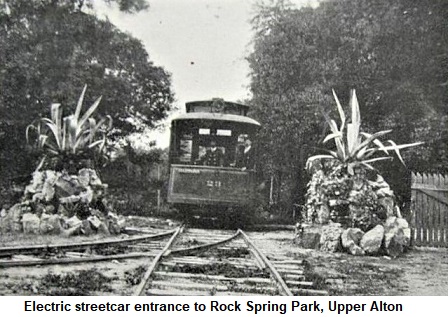Early Upper Alton History
(Includes Milton, Salu, Forkeyville, and Rock Spring Park)
Upper Alton Newspaper Articles | Rock Spring Park Newspaper Articles
Milton Newspaper Articles | Forkeyville Newspaper Articles
Early Settlers
Upper Alton came into existence about the same time as Lower Alton,
although in the early years of its history it had a more vigorous
growth than Lower Alton. Joseph Meacham, a native of Vermont who
came to Illinois in 1811, was the original founder. He surveyed the
site of the town into lots in 1817, and proposed to sell the lots by
lottery – each ticket entitling the holder to one lot, or thirty
acres, more or less. For some years there was considerable problems
with the titles for the land. Meacham had only paid the Land Office
one fourth of the amount due. Under the existing rules then in
force, he received a certificate of entry, and was entitled to a
patent on payment of the balance of the purchase money.
Subsequently, he became financially embarrassed, and was unable to
pay his debts. He assigned his certificate to James W. Whitney,
Erastus Brown, John Allen, and Ebenezer Hodges, who paid the balance
due the Land Office, and obtained a patent. Meanwhile, Ninian
Edwards and Charles W. Hunter had procured judgments against
Meacham, and sold a number of lots for which deeds had been given by
Meacham while he held the certificate of entry. Litigation followed,
and a compromise was finally made where Whitney, Brown, Allen,
Hodges, Edwards, and Hunter, divided most of the lots between them,
while the original purchaser was crowded out entirely. Meacham,
after founding Upper Alton, purchased what was known as the Bates
farm (about where the Alton City Cemetery is now located), and
projected a town which he advertised as “Alton on the River.” Major
Charles W. Hunter became interested in this last enterprise in 1818,
purchased the land, and out of it grew Hunterstown, now part of Alton. This “Alton on
the River,” later called Hunterstown, was land east of Henry Street
in Alton, and west of Milton near the Wood River.
For some years after 1817, Upper Alton (known then by the name of
Alton) surpassed Lower Alton in population and improvements. Among
the early settlers were: Dr. Augustus Langworthy, Ebenezer Hodges,
James W. Whitney, Robert Sinclair, Elisha Dodge, William Kessler,
Benjamin Spencer, Hezekiah H. Gear, Isaac Woodburn, Benjamin
Steadman, David Smith, George Smith, Erastus Brown, Rev. Bennett
Maxey, John A. Maxey, John Seeley, Nathaniel Pinckard, William G.
Pinckard, John Allen, Willis Webb, Benjamin Hail, Samuel Delaplain,
Henry P. Rundle, Alanson S. Wells, Jonathan Brown, Ephraim Marsh,
Levi McNeil, Thomas Allen, Zachariah Allen, Shadrach Brown, William
Heath, Daniel Crume, Enoch Long, and Joel Finch (see some of their
histories below).
Dr. Augustus Langworthy Sr.
came to Illinois from Vermont, where he was born on November 29,
1788. He studied medicine, and in 1816 settled in Upper Alton, where
he began the practice of his profession and served as one of the
first trustees of the town. On the establishment of the post office
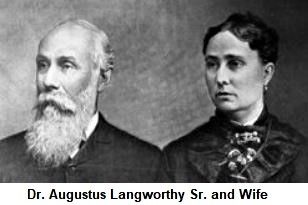
Ebenezer and Mary Hodges lived in a
log cabin in Upper Alton, where the first preaching in Upper Alton
was held in 1817 by Methodist preacher, Rev. Samuel H. Thompson. The
early members named their congregation the “Wesley Church.” Hodges’
cabin was located where the original Baptist Church of Upper Alton
was erected in 1837, at the northeast corner of Seminary and College
Avenue. Some of the original members of the Methodist Church
included Ebenezer and Mary Hodges, Jonathan Brown, Delilah Brown,
Oliver Brown, Mary Woodburn, and John Seeley. Ebenezer Hodges later
moved to Greene County, Illinois, where he died, and is buried in
the North Cemetery in White Hall.
James W. Whitney was a lawyer, and
was one of the first trustees of Upper Alton. He died in Adams
County at the age of eighty-five. He was familiarly called “Lord
Coke.” Among the papers of George Churchill was found this
memorandum: “Whitney is a Yankee from the vicinity of Boston, and
came to this country in 1800. He has been 2,500 miles up the
Missouri River, and was taken prisoner by the Indians.”
Robert Sinclair was Deputy Sheriff
in Upper Alton. He was shrewd, eccentric, and illiterate. He was
found guilty of complicity in a robbery, and though present when the
verdict was rendered, he escaped before the officials could secure
him. He fled to Crawford County, Arkansas, became popular there, and
was elected a member of the State Legislature in the latter part of
1829, and served until 1833. He died in Little Rock, Arkansas, in
November 1833, at the age of 37 or 38, and is buried in the
Peevyhouse Cemetery, Van Buren, Arkansas.
Benjamin Spencer lived in Upper
Alton, where he served as one of the first trustees, and in 1818 was
a Justice of the Peace. He then moved to Lower Alton, where he was a
builder and Justice of the Peace for several years. He was a
gentleman, and highly esteemed by all who knew him.
Dr. Erastus Brown was born in 1780
in Connecticut. He married Brittania Easton Starr, following the
death of her husband, Samuel Starr, in 1810. Between 1815-1818, the
Brown family moved to St. Louis, Missouri (possibly due to influence
of Colonel Rufus Easton, Brittania's brother and founder of Alton),
and soon thereafter to Upper Alton. It is believed their son, Edward
Salisbury Brown, was born in Upper Alton in 1819. Erastus was a physician
and the proprietor of the first drugstore in Upper Alton. Their home
in Upper Alton stood on the Milton road, just where that road joined
the main street of the town. Dr. Brown was a handsome man of slim
build, over six feet tall, and as straight as an arrow. His
complexion was clear, and his hair and eyes were jet black. He was a
man of positive character, and always identified himself with the
civic movements looking to upbuild the community. Erastus, along
with Rev. Bennett Maxey, Isaac Waters, and Zachariah Allen, laid out
the town of Salu, north of Upper Alton, in 1825. Dr. Brown was the
first to own the land at 2903 Edwards Street in Upper Alton. Dr.
Brown died on August 28, 1833, in Alton. His burial place is
unknown.
Rev. Bennett Maxey was born October
4, 1769, in Powhatan County, Virginia. He first settled in
the town of Milton near Upper Alton, then moved to Upper Alton. He
was the first minister of the Gospel in Upper Alton. He, along with
Dr. Erastus Brown, Isaac Waters, and Zachariah, Allen, laid out the
town of Salu, north of Upper Alton, in 1825. Rev. Maxey died
November 29, 1837, and is buried in the Oakwood Cemetery in Upper
Alton. The grandsons of
Bennett Maxey ran a saloon out of the front of the Maxey homestead
on Washington Avenue, two blocks north of College Avenue. This home
was one of the oldest in Upper Alton, being built about 1812. The
land had previously been owned by Ebenezer Hodges, and consisted of
255 acres. After several lawsuits concerning the land, it was
divided up, and after passing through several hands, become the
property of Rev. Bennett Maxey, who built a log home on the
property. This home also served as the post office. Travelers would
stop at the Maxey saloon for a drink and rest during their travels
through the area. Samuel B. Taggart bought the homestead from the
Maxey heirs in about 1872. Israel H. Streeper occupied the home with
the Maxeys at one time. The home was torn down in about 1912.
John Anderson Maxey was the son of
Rev. Bennett Maxey. He was born in 1799 in Virginia. When five years
old, his family left Virginia and moved to Ohio, then in 1817
settled in the flourishing town of Milton near Upper Alton. A few
years later, his father bought land in Upper Alton. John Maxey was
elected Constable of Upper Alton, and in 1821 was elected Constable.
In 1824, he was commissioned a U.S. mail carrier, his route being
from Belleville to St. Charles, Missouri, via Edwardsville, Upper
Alton, and Portage de Sioux. The mail went over this route twice a
week by horseback. In 1834, he was elected Justice of the Peace in
Upper Alton, which he held for over 30 years. In 1832, he married
Sarah Beem, and they had four children. Mr. Maxey died in January
1877, and is buried in the Upper Alton Oakwood Cemetery.
William G. Pinckard was the son of
Nathaniel Pinckard. In 1818, William Pinckard, wife (Elizabeth
Warner Pinckard, born June 15, 1795 in Fairfax County, Virginia),
and child; William Heath, wife and child; and Daniel Crume, their
brother-in-law, immigrated from Springfield, Ohio to Illinois. They
arrived on October 15, 1818, at what is now known as “Bozzatown,” at
the foot of Washington Avenue, east of Lower Alton. They found a
“half-faced” camp, where the whole party lived for nearly two
months. It was about sixteen feet square, with a clapboard roof with
a hole in it through which the smoke of their fire escaped. Major
Charles W. Hunter made them an offer that if they would establish a
pottery on his land, he would give them town lots. The proposition
was partially agreed to, and the group built a cabin of round logs
on Shields’ Branch, about 100 yards north, which they moved into one
week before Christmas, 1818. During the winter of 1818-19, Pinckard
and Crume contracted to build a house for Colonel Rufus Easton,
founder of Lower Alton. It stood near the corner of Broadway and
Piasa Streets. In 1819, Pinckard, Crume, and Heath erected a frame
house in Hunterstown, on Broadway. The pottery business was never
carried out, and their old cabin remained for many years. As late as
1830 or 1831, it was used as a meetinghouse for the Methodists.
Thomas Stanton Pinckard, a son of
William G. Pinckard, had a vivid recollection of several of the old
settlers who were living in Upper Alton when he was a boy. “Abel
Moore,” he wrote, “in his Dearborn wagon with his wooden leg.
Tommy
Nichols, with his favorite byword ‘Dad-burn it.’ Old
McAuley; old
George Bell – all old rangers during the Indian troubles. Often
these men visited my father’s house when I was a boy, and by a
bright, glowing fireplace, seated on father’s knee, I listened to
the hair-breadth escapes and thrilling incidents of border life. The
murder of the Reagan and Moore family in the forks of the Wood River
in 1814 was often spoken of by these old rangers, some of whom
participated in the pursuit and killing of the savage murderers. It
was a common occurrence for us children to pick up Indian arrowheads
in the timber and fields of Middle Alton, up to 1840.”
During the winter of 1819, Nathaniel
Pinckard, an early Methodist preacher from Culpepper County,
Virginia, and later Springfield, Ohio, arrived in Bozzatown and
found the families of his son, William G. Pinckard,
Daniel Crume,
and William Heath all sick, and one of them dead (it is unknown if
this was a wife or child). He at once determined to move them from
the lowlands of Hunterstown, and rented a log house of two rooms,
with a chimney in the center. Here they all spent the winter if 1819
and 1820. Dr. Erastus Brown and Rev. Bennett Maxey, founders of the
town of Salu north of Upper Alton, gave them lots on which to erect
buildings for a pottery and tannery. They built a pottery the same
winter, and were all ready to manufacture ware in the Spring of
1820. The demand for ware was good, and they had a thriving
business. People came from near and far to buy dishes, cups, crocks,
etc. They soon built comfortable and roomy residences and were doing
financially well. The houses of both Nathaniel and William Pinckard
served as stopping places for pioneer preachers passing through
Upper Alton. Religious services were often held in their homes.
Nathaniel Pinckard also served as Justice of the Peace in Upper
Alton. In 1834, William Pinckard moved from Upper Alton to Lower
Alton, and in 1837 moved to Middle Alton, and in 1846 back to Lower
Alton, where he died on March 13 1866. He is buried in the Alton
City Cemetery. His son, William G. Pinckard Jr., was killed in 1864
by friendly fire during the Civil War.
Deacon Enoch Long was brother to
Dr. Benjamin F. Long, Colonel Stephen H. Long, Edward Preble Long,
and Major George W. Long, all men of
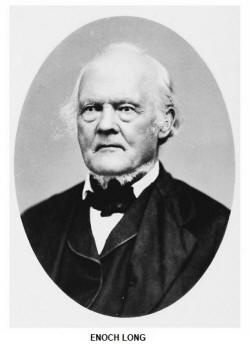
Samuel Delaplain was born in
France, and accompanied his father to America at a very early date.
He lived for some years in Macon County, Kentucky, and came to
Illinois in 1807. For a short time, he was a resident of St. Louis,
then lived near Edwardsville, where he erected a mill on Frank’s
Branch of Cahokia Creek. In 1815, he transformed his mill into a
water mill. He then settled in Upper Alton. His son, Benjamin
Delaplain, was accustomed to relate the tale of how the family took
refuge in nearby forts due to Indian hostilities. Samuel learned the
trade of carpenter, and for a number of years kept the Alton House
in Alton. He then moved to a farm in Godfrey Township in 1861, and
died there in 1876. His wife was Elizabeth Reed Delaplain.
Henry P. Rundle was a tailor by
trade, and carried on business for some time in Upper Alton. His
wife was the daughter of Samuel Delaplain. He later moved to
Scarritt’s Prairie, where he was a member of the Bethany Church.
Zachariah Allen was an early
pioneer of Upper Alton. He, along with Bennett Maxey, Erastus Brown,
and Isaac Waters, laid out the town of Salu, north of Upper Alton.
The plat was recorded August 1, 1825.
First Postmasters
The first postmaster in Upper Alton was Augustus Langworthy, who was
appointed in 1818, and was succeeded by Rev. Bennett Maxey in 1824.
Maxey’s residence was in Salu, and consequently the post office’s
name was changed to Salu. In 1826, he resigned the office, and
George Smith received the commission. The office was then brought
back to Upper Alton, and then name changed to “Alton.” In 1835,
David Smith received the appointment as postmaster. The name of the
office was then changed to Upper Alton, and the post office at Lower
Alton, which bore the name of Lower Alton, was changed to Alton. In
1849 Frank Hewitt was appointed postmaster, and was succeeded in
1853 by Joseph Chapman. James Smith was next placed in charge of the
office. Aaron Butler was commissioned in 1861, and was followed in
1866 by Rev. T. B. Hurlburt. Aaron Butler was re-appointed in 1867.
Joseph H. Weeks was appointed in 1877, and remained so through 1882.
A Growing Community
In 1831, Upper Alton was described as have thirty-five families and
two hundred souls. It had two stores, one tavern, one blacksmith
shop, one ox flouring mill, one wagon maker, one tannery, one
saddlery, one shoemaker, one brick maker, two carpenters, two
physicians, one pottery, a post office, and a brick schoolhouse.
Three years later, in 1834, Upper Alton had three stores, one house
of entertainment, three physicians, various mechanics, a pottery, a
brick schoolhouse, a steam flouring mill, but no grocery or whiskey
shop. About sixty families resided there at that time. J. S. Nutter
and J. L. Bingham opened a new livery stable in Upper Alton in 1836,
and a new Lyceum was opened. In 1839, Upper Alton had eight stores,
five groceries, two lawyers, five physicians, mechanics of various
descriptions, a steam saw and flour mill, and about three hundred
families.
In 1835 a stone building was erected by John Higham and Mrs.
Caswell, both pioneer residents. It was an early residence of Rev.
Thaddeus B Hurlbut, and was located at the southeast corner of
College Avenue and Clawson Street. The first Anti-Slavery Society in
Illinois was organized there in 1837. It was later owned for years
by Dr. Isaac Moore, and then by Major Frank Moore, son of Captain
Abel Moore. It was later turned into a double dwelling house. Mr.
Higham occupied the east side of the building. His daughter was Mrs.
John Bostwick, who met Rev. Elijah P. Lovejoy as she was returning
from school at Jacksonville in a stage coach. Mr. Lovejoy produced a
cigar and asked if she objected to tobacco smoke. She said she did.
To this he replied, “Some people do,” and proceeded to smoke his
cigar. This stone building still stands today, and is known as the
“Rock House.” It is used as an apartment building.
Upper Alton Business in 1861
Physician and Surgeon – Dr. Frederick Humbert and Dr. Henry Kent
Lathy
Madison House (hotel) – Benjamin Delaplain
Upper Alton House (hotel) – Mrs. Day
Postmaster – J. Smith
Dry Goods and Groceries – F. Hewit
Stove, Hardware and Tin store – John Kell & Son
Grocery and Provisions, Masonic Hall – William Campbell
Salamander Pottery – Hugh Sawyer
Aetna Insurance Agent – Joseph Chapman
Attorney & Justice of the Peace – J. B. Randall
School for Young Ladies – Mrs. Willetts
Horse Railway
In 1867 the horse streetcar was established in Upper Alton,
connecting Upper Alton to Alton. The railway was promoted primarily
by Cyrus Edwards. A committee was formed in 1865 with
representatives from Alton and Upper Alton. A charter was accepted
on March 27, 1867. By April, $6,000 had been subscribed in Upper
Alton for the cost of building the railway. It was completed in
December 1867. The office for the railway was located in the Alton
City Hall. This system continued for about 25 years, when the
electric streetcar took the place of a horse-pulled streetcar.
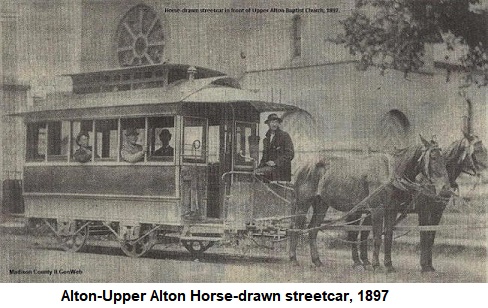
1882 Businesses
General merchants – E. G. Webster, Thomas R. Murphy, and Henry Loehr
Grocers – Mahlon Malson, E. O. Reader, August Hildebrand, and Albert
H. Hastings
Drugstores – Henry C. Swift and Fred J. Stebbins
Books, stationery, and gents’ furnishings – M. A. Leverett
Stoves and tinware – Evan E. Betts
Boots and shoes – Mrs. K. K. Boyle and Louis Ehrler
Baker – Friedrich Lugwig Vogelpohl
Butchers – Bradley & Co., and Albert H. Hastings
Shoemaker – Henry L. Walke
Wagon makers – Robert R. and John McReynolds
Architect and builder – Oliver G. Stelle
Undertaker – Israel H. Streeper
Cigar Manufactory – H. S. Darnielle and H. H. Rippe
Attorney – Cyrus W. Leverett
Justices of the Peace – Daniel W. Collett and Amos E. Benbow
Physicians – T. P. Yerkes, Edward C. Lemen, and Henry T. Burnap
Principal of Public Schools – Benjamin P. Harris
Rock Spring Park
As early as 1862, reference was made in the early newspapers to a
stone spring between Middletown and Upper Alton. It was a popular
spot for picnics and strolling through the tree-lined paths. This
same spring had been used by Indians as they passed through the
area. A clear spring poured through a cleft in a large rock at the
foot of a hill, and provided drinking water to all who wanted to
partake. During the Civil War, soldiers encamped near the wooded
area west of Upper Alton. Legend has it that the ladies of Upper
Alton baked them pies, and Upper Alton took on the nickname of “Pie
Town.”
In 1896, Harry Marsh owned the property which later became Rock
Spring Park, and sold it to Joseph F. Porter, President of the Alton
Railway and Illuminating Company. This land was along the route of
the electric streetcar, and it was his dream to renovate the park
for picnics, concerts, and other popular amusements. He ran a track
into the park, and began making improvements such as planting 200
trees, shrubs, flower beds, a pavilion, a playhouse, a greenhouse,
and a small lake with a bridge. On June 15, 1907, the park
officially opened to the public. Over two thousand attended the
grand opening, and enjoyed an arcade, merry-go-round, dance hall,
shooting gallery, parlor bowling, novelty balls, refreshment stands,
and the Rock Spring Theater with vaudeville.
In 1907, William Eliot Smith offered 60 acres of land adjacent to
Joseph Porter’s Rock Spring Park to the city as a permanent park
site, provided Joseph Porter would donate his land also. This was
accepted by Porter, and Rock Spring Park officially became the
property of Upper Alton in 1908. In May 1914, the Rock Spring
Country Club had its formal opening, which was a new social center.
The new clubhouse and club grounds were very popular with golfers.
Upper Alton Annexed into Alton
In 1911, Upper Alton was annexed into Alton. At that time, it had
several miles of paved streets, two street railroads, a water works
system, and electric lights. No saloons existed after the
establishment of Shurtleff College, who forbade the sale of liquor
within one mile of the college.
Early Schools
The first schoolhouse was a small log cabin, about fourteen feet
square. The floor was of rough-hewn, split logs, laid in a manner as
rough as the material. This structure stood in the southern part of
Upper Alton, and was soon replaced by another building more
centrally located on the street leading to Milton. This was likewise
built of logs, but was more commodious and comfortable than its
predecessor, and was used for several years. The seats were made out
of slabs hauled from the sawmill at Milton. One of the pupils of
those days writes: “The small scholars were required to sit on these
miserable benches without backs, and be very quiet, though some of
the smallest could not reach the floor with their feet. The larger
scholars were better provided for, as their seats were next to the
wall, and a board was placed in front of them for a writing desk.
Our school books were – Webster’s Speller, Walker’s Dictionary,
Pike’s Arithmetic, Murray’s Reader, and Murray’s English Grammar.”
Among the early teachers of this school were: Mr. Rose, Nelson
Aldrich, H. H. Snow, Enoch Long, Rowlet Maxey, and Levi McNeil. For
a short time, a man named Jinks served as teacher, but was
discharged for lying down and sleeping on the benches during school
hours. His devotion to whiskey was the cause. Except for this, he
was an excellent teacher.
In November 1841, Mrs. Hurlbut opened a private school in a building
formerly occupied as a store. Orthography, reading, writing,
geography, grammar, history, arithmetic, philosophy, composition,
rhetoric, logic, botany, chemistry, and astronomy were taught.
Lincoln School (later called Dunbar) was constructed in 1895 for the
African-American children living in the Salu area. When Upper Alton
was annexed to Alton, and there being a Lincoln School in Alton
already, the name was changed to Dunbar. Dunbar closed in 1975, and
was razed in 1991.
Gillham School was located on Main Street just south of Upper Alton.
It was a two-room frame building. This building was later torn down,
a new building erected in 1921, and renamed Clara Barton School.
Upper Alton High School was erected in the late 1800s, at the
northwest corner of Edwards and Seminary Street. When Upper Alton
was annexed into Alton in 1911, this school ceased to exist as a
high school. The building was converted into Horace Mann Elementary
School. Later, the old building was torn down and a new modern
Horace Mann School was erected.
Alton Seminary/Shurtleff College was founded in 1832 in Upper Alton
when Rev. John Mason Peck moved his Rock Spring Seminary into the
community. Rev. Hubbel Loomis was one of the first instructors. In 1835,
when Rev. Peck appealed to Benjamin Shurtleff of Boston for
additional funds for his growing school, Shurtleff proposed giving
$10,000 (a large sum in its time) for building purposes, if he would
rename the school Shurtleff College, which Peck agreed to. The
school grew in size and reputation, ending its existence on June 30,
1957. Today the property is home to the Southern Illinois University
Dental School.
In 1879, Edward Wyman of St. Louis founded the Wyman Institute on Seminary Street
in the former John Bostwick home in Upper Alton. It was a school for
young men, and was popular in the area. Wyman died sitting at his
desk at the school, in May 1888. The Wyman Institute later became
the Western Military Academy.
Early Churches
From the time they made their home in Upper Alton, the houses of
Nathaniel Pinckard and William G. Pinckard were the stopping places
of the pioneer preachers, and religious services were often held at
their houses, and also at that of Jonathan Brown. The Reverends
Samuel Thompson, Thomas Randle, John Dew, and Jesse Walker were
among the early ministers. The first Sunday School in Illinois was
opened in Upper Alton in 1817.
A Methodist Sunday School was formed at Upper Alton in 1817, with
members Ebenezer Hodges, Mary Hodges, Jonathan Brown, Delilah Brown,
Oliver Brown, and John Seely. Mrs. Mary Woodburn was added, along
with the wife of William G. Pinckard. The first religious services
were held in the cabin of Ebenezer Hodges, which stood where the
Baptist Church was later erected. John Dew may have been the first
preacher. Rev. Samuel H. Thompson officiated as pastor from 1818 to
1820. In 1835, the first church edifice, a frame building, was
erected. In 1849 a brick church was constructed.
The Baptist Church in Upper Alton was organized in April 25, 1830 by
Rev. John M. Peck. There were eight original members – Ephraim
Marsh, James D. W. Marsh, Don Alonzo Spaulding, Mrs. Frances Marsh,
and Rachel Garrett. Rev. Ebenezer Rodgers was the pastor from 1834
to 1838. The name at that time was Alton Baptist Church. For nearly
six years services were held in either private homes or in what was
known as the brick schoolhouse. In 1836, a house of worship was
completed, and used by the congregation for more than thirty years.
In May 1868, the Second Baptist Church (colored) was organized at
the Salem schoolhouse in Upper Alton. The names of the original
members were Cyrus M. Howard and wife, John A. Howard, W. Scott and
wife, Eliza Grason, Mary A. Wilson, Martha Broner, Martha Foster,
and James Brown. The council that organized the church was Rev.
Washington Leverett, Rev. Tilbury, Rev. H. C. Hazen, and George A.
Cressy. Subsequently, they were recognized as a regular Baptist
Church. In 1869 they erected a house of worship at a cost of $1,400.
It was dedicated in September 1869. The church was 36 x 56 feet,
with 14-foot ceiling. Early pastors of this church include J.
Robinson, W. H. Howard, William Webster, W. H. Willitt, and W. C.
Carter.
The Presbyterian Church was organized in 1837 at the home of Deacon
Enoch Long, at the corner of Main and College Avenue, with
twenty-four members. The first minister was the Rev. Elijah P.
Lovejoy, then a resident of Alton, and publisher of the Alton
Observer. He was killed by a mob in Alton in November 1837. In 1838,
twenty-six new members were added. A house of worship was erected in
1838, and in 1858 destroyed by fire. A new church building was
partially completed in 1861, and was dedicated in 1865.
EARLY HISTORY OF MILTON
Milton was laid out by John Wallace and Walter J. Seely sometime in
about 1809. It was located in section 17 in Wood River Township,
where the Wood River, with its small rapids, divided the future East
Alton from Alton. John Wallace erected a large mill on the Wood
River, which at that time was large enough for keel boats to
navigated up from the Mississippi.
There were other mills in Milton - two sawmills, and a grist or
flour mill. William and John Whiteside attempted to build a water
powered mill on the Wood River as early as 1806, but their effort
was not successful.
Milton became a bustling, active village – even larger than the
fledgling settlement at the future site of Alton. A. W. Donohue
erected a store building at the bridge in Milton, with R. T. McHenry
in charge. Milton also had a distillery and a tavern.
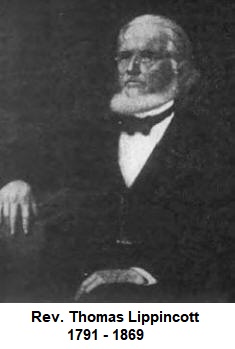
Travelers arriving in Milton in their wagons procured necessary
supplies at the Lippincott store and pushed on westward, not going
up the river to Alton. Some traveled up the hill to the town of Salu
(Upper Alton), then on northward through Scarritt’s Prairie
(Godfrey). Thus, Salu grew quite quickly, many stopping there
permanently.
In September 1818 William Greene Pinckard and family arrived at
Milton in a wagon, after a long overland trip from London, Ohio.
They purchased supplies from Rev. Lippincott, and proceeded west up
the river to what was called Shield’s Branch (now Bozzatown). Here,
he and his family, along with his brother-in-law, Daniel Crume,
remained for the winter.
In the summer of 1819, Mr. Robert Collet, a merchant of St. Louis,
bought out the interest of Mr. Walter Seely in Milton – thus Wallace
and Collett became the proprietors of the village and mill. Mr.
Collett kept a store there.
Power for the mills was obtained by a dam across the Wood River. The
still, stagnant water in back of the dam soon caused an outbreak of
sickness. Many of the inhabitants of Milton died of malarial fever,
and were buried on the adjacent hillside in the Milton Cemetery. The
remaining settlers quickly abandoned their homes and left Milton, in
fear of coming down with the sickness. The tavern was moved to Upper
Alton. The sawmill was abandoned in about 1830, when Alton began to
show signs of life. Today, nothing is left of Milton except for the
cemetery, which holds the remains of the original inhabitants. The
log buildings were torn down and the materials used elsewhere.
EARLY HISTORY OF SALU
Bennett Maxey, Erastus Brown, Isaac Waters, and Zachariah Allen laid
out the town of Salu, adjoining Upper Alton to the north. In an
advertisement in the Edwardsville Spectator in 1820, the town of
Salu was described as thus:
“The site for the town of Salu is considered more eligible than
others which can be selected on the waters of the Illinois and
Mississippi Rivers. This town is situated on the first high,
rolling, and commanding ground from the river, north of Upper Alton.
There are no ponds nor stagnant waters – the source of so much
disease in this country, but it is well supplied with springs of
pure water. Good mechanics of moral, industrious habits and
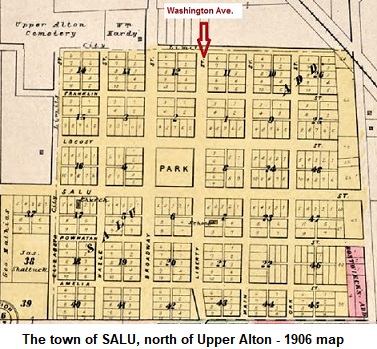
In 1832, Isaac Warnack settled in the village of Salu with his
mother, Elizabeth, and his brother, Henry Warnack. Warnack purchased
34 acres where a pottery was established by 1843. It was located on
Salu Street, west of Seminary Street. The Warnack pottery employed
five men in 1850. They used a technique of dipping salt-glazed
vessels, which created a distinctive two-tone effect. The pottery
ceased production in 1868.
In later years, Salu became home to a large portion of the
African-American community in Upper Alton, including former slaves.
Salu was annexed into Upper Alton.
EARLY HISTORY OF FORKEYVILLE
Forkeyville is located east of Upper Alton at the “fork of the
roads” leading to Bethalto and Fosterburg. The road leading to
Bethalto was College Avenue, also named Rt. 160, and then changed to
Rt. 140. There was a saloon at the “forks in the road” as early as
1895, which was owned by Charles Isenberg. Isenberg sold the saloon
and moved to Bethalto to open a butcher shop. This saloon served as
a rest stop for travelers going to and from Fosterburg or Bethalto.
In 1904 the saloon owner was C. A. Wildi, who was arrested and fined
for operating a saloon without a license. It was cheaper to run the
saloon without a license and pay the fine, rather than pay the
larger amount for a license. Wildi quit the business and closed up
the saloon in 1906, however he rented out his two-story home to
Peter Edsall, just opposite the saloon. This house was destroyed by
fire in 1906.
In 1913 the Forkeyville saloon was sold by C. A. Wildi to Barr
Dailey for $2,000. At this time, the Alton State Hospital was in the
planning stages, and Dailey knew that traffic would increase past
the saloon and he saw an opportunity for profit. He began making
improvements on the “triangle of property,” starting with the old
house where the Forkeyville saloon was formerly kept. However, the
Illinois State’s Attorney made a public statement that he would not
allow an “illicit” saloon to operate there at Forkeyville, and the
Mayor of Upper Alton stated he would not issue a liquor license. The
saloon by this time had a bad reputation, and the youth of the
Western Military Academy and Shurtleff College sometimes visited the
saloon, against the wishes of both institutions. Mr. Dailey decided
to open a dry goods store instead, selling a complete line of
groceries, dry goods, and general produce. In 1919, Daniel Hartnett
Jr. purchased the store from William Dailey, and then turned the
store over to his son to conduct the business.
In 1929, the State constructed a new bridge over the Wood River
between Upper Alton and Forkeyville. During construction the bridge
fell into the water three times due to heavy rains, and the
supporting pilings were washed away. With the introduction of
automobiles and the increase of their popularity, Hartnett decided
to build a filling station at Forkeyville in 1929. This included a
canopy over the station, with offices and a storeroom. A roadway was
cut through his property to Fosterburg Road.
Forkeyville changed hands many times, and through the years never
quite shook the reputation it had once obtained. The filling station
and bar operated for many years under the names of Forkeyville
Lounge, Eldorado Club, McNeil’s Pub, and Clover Club Tavern. The
building was finally torn down in 2010 after the owners were cited
for property code violations. A used car lot, several small homes,
and a gas station currently occupy the area.
In the late 1950s and early 1960s, protection from a nuclear attack
was a major concern throughout the country. The Mississippi Lime
mine, just across Highway 140 at Forkeyville, was considered a
potential bomb shelter. “Survival supplies” were stored in the mine
in case of an attack.
